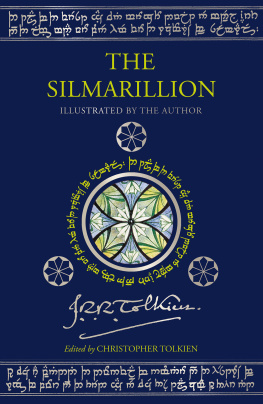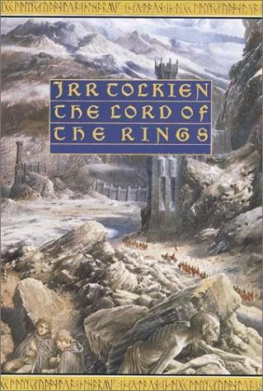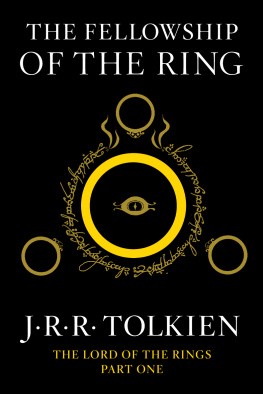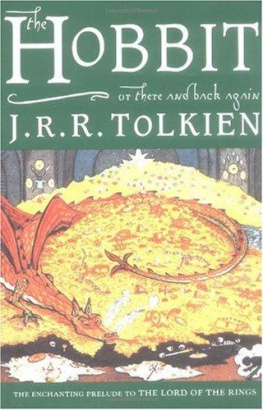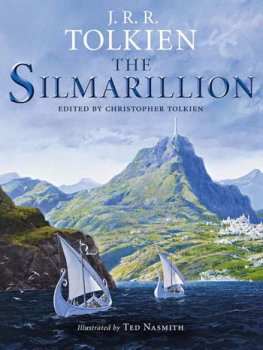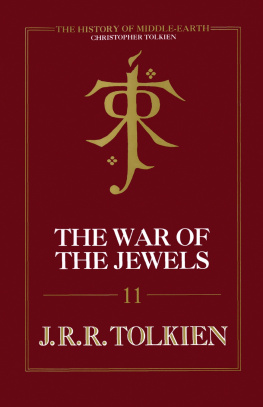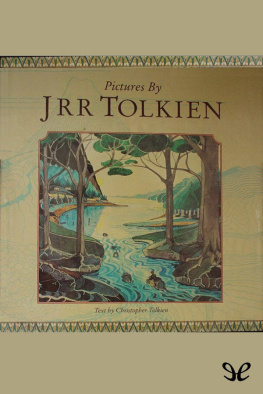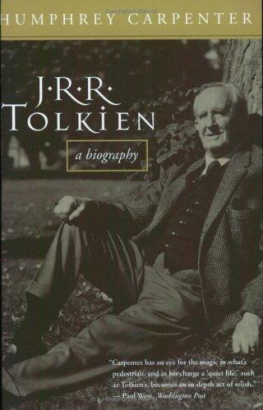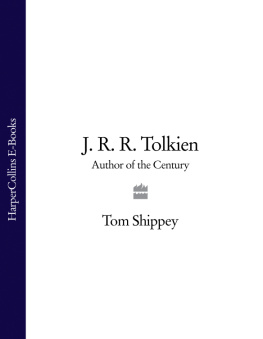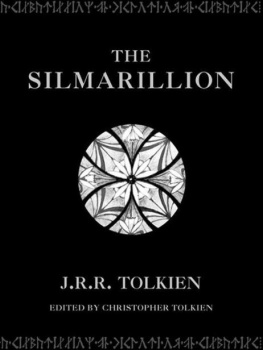J.R.R. Tolkien - The Silmarillion (2022 Version)
Here you can read online J.R.R. Tolkien - The Silmarillion (2022 Version) full text of the book (entire story) in english for free. Download pdf and epub, get meaning, cover and reviews about this ebook. year: 2022, publisher: HarperCollinsPublishers, genre: Religion. Description of the work, (preface) as well as reviews are available. Best literature library LitArk.com created for fans of good reading and offers a wide selection of genres:
Romance novel
Science fiction
Adventure
Detective
Science
History
Home and family
Prose
Art
Politics
Computer
Non-fiction
Religion
Business
Children
Humor
Choose a favorite category and find really read worthwhile books. Enjoy immersion in the world of imagination, feel the emotions of the characters or learn something new for yourself, make an fascinating discovery.
- Book:The Silmarillion (2022 Version)
- Author:
- Publisher:HarperCollinsPublishers
- Genre:
- Year:2022
- Rating:3 / 5
- Favourites:Add to favourites
- Your mark:
- 60
- 1
- 2
- 3
- 4
- 5
The Silmarillion (2022 Version): summary, description and annotation
We offer to read an annotation, description, summary or preface (depends on what the author of the book "The Silmarillion (2022 Version)" wrote himself). If you haven't found the necessary information about the book — write in the comments, we will try to find it.
The Silmarillion (2022 Version) — read online for free the complete book (whole text) full work
Below is the text of the book, divided by pages. System saving the place of the last page read, allows you to conveniently read the book "The Silmarillion (2022 Version)" online for free, without having to search again every time where you left off. Put a bookmark, and you can go to the page where you finished reading at any time.
Font size:
Interval:
Bookmark:


Tolkien said of his Silmarillion mythology, which occupied him for most of his life, that it grew out of a desire to support languages he had created, which he decided could not exist in a void, and to provide for his beloved England a body of heroic stories bound up with its tongue and soil. It was a majestic and ultimately highly complex effort, which began with poems he composed as a young man. The earliest of these, from September 1914, was The Voyage of arendel the Evening Star. Inspired by a line from the Old English Crist, El Earendel engla beorhtast | Ofer middangeard monnum sended Hail Earendel, brightest of angels, above the Middle-earth sent unto men. It was not at first connected to a larger literary scheme; but in time arendel (in The Silmarillion, Erendil) became a mariner who sails west from Middle-earth to seek the help of the Valar, greatest of the angelic powers, against Morgoth, Lord of Darkness, and with a Silmaril, one of the great jewels made by the Elven artisan Fanor, is set to sail in the sky as a star, a sign of hope to the oppressed.
In addition to its roots in storytelling and language, The Silmarillion was created also through painting and drawing. Tolkienwas a keen amateur artist, skilled with pencil, pen, and brush. Someof his pictures are preserved in a sketch-book he called The Book ofIshness, because it contained depictions of ideas symbolic or abstract, such as Grownupishness and Undertenishness. He drew places he visited and lived, but also captured remarkable visions associated with his mythology. Indeed, from the time he composed his arendel poem, nearly all of his illustrative art was inspired by his own writings.
One of his pictures, Water, Wind & Sand [facing p. 234], is inscribed Illustration to Sea Song of an Elder Day, a poem which began as an impression of the sea and became, as revised, enlarged, and retitled The Horns of Ylmir, the song Tuor sings to his son arendel in their exile after the fall of Gondolin. The painting captures very well the emotional flavour of rock and wave when the sea is rough, but as in a dream, stylized and in extraordinarily bright colours. Tolkien had heard the call of the Sea, glorious and sad the music of the Horns of Ylmir (in the developed mythology, Ulmo, Lord of Waters) and could convey its darker tones in his art.
He painted Water, Wind & Sand, however, in early 1915, before the poem it illustrates gained its Silmarillion frame-story of Tuor andthe visions that Ylmirs conches once called before him in the twilight in the Land of Willows. But even at that moment of composition, Tolkien must have had in mind the idea of someone transported to the sea in his thoughts and soul if not in body. The small figure in the painting is in the midst of the elements yet set apart from them. Perhaps it is meant to be Tolkien himself, experiencing at close hand the crash of the waves. But we cannot discount the possibility that this was the seed from which the frame-story emerged and the poem was absorbed into the legend of Tuor. Tolkiens creativity sometimes worked in advance of his consciousness, and the painter occasionally preceded the poet.
This is evident also in Tanaqui [facing p. 26], another work from early 1915, as far as we can judge. Its title contains linguistic roots from Tolkiens Elvish language Qenya (later Quenya) meaning high, lofty and white, similar to the name Taniquetil which we meetlater. (Around this time, he also began to make a dictionary of Qenya,in which he invented aspects of his mythology along with elements oflanguage.) There can be no doubt that the painting is to be associatedwith, and probably preceded, the poem Kr, dated 30 April 1915:
A sable hill, gigantic, rampart-crowned
Stands gazing out across an azure sea
Under an azure sky, on whose dark ground
Impearled as gainst a floor of porphyry
Gleam marble temples white, and dazzling halls.
Kr in Tolkiens early writings was both the city of the Elves in Eldamar and the hill on which it was built; in later accounts, it is called Tirion upon Tna. In Tanaqui Tolkien illustrated details not in the related poem but later expressed in prose, in this case the slender silver tower of the house of Inw shooting skyward like a needle, described in an account in The Book of Lost Tales. There a white lamp of piercing ray set in the tower shone upon the shadows of the bay; in Tanaqui a lamp shines not from the tower but from a tall, tiered building on the left. The pale blue construction in the centre of the picture is possibly a road climbing sharply up to the city. Above this appears to be a round-headed tree, perhaps a scion of one of the Two Trees given by the Valar to the Elves of Kr; a similar stylized form appears to the right of the tall tower. The view looks forward to the drawing Tolkien made in 1928 of the Elven city of Gondolin, built of white stone upon the hill Amon Gwareth.
Kr also appears in the painting generally called The Shores of Faery [facing p. 50], which illustrates, and faces in The Book of Ishness, the earliest version of the poem with that title. The picture is dated May 10 1915, two months earlier than the date of original composition (89 July) Tolkien inscribed on a revised manuscript. In fact, the title he gave to the painting is, we believe, West of the Moon, East of the Sun, recalling the name of a popular Norwegian fairy-story. Tolkien seems to have painted his picture, written its title on the facing page in form and a central position like some other picture titles in his sketch-book, then was inspired to compose a poem, written below and incorporating the title of the painting as its first lines. After this, he inscribed The Shores of Faery, as the poems title, at the top of the sheet.
The phrase the Shores of Faery refers in Tolkiens mythology to the lands along the great bay on the east coast of Valinor in Aman, in or near which the Elves built their dwellings. The Two Trees, Silpion (later Telperion) and Laurelin, provided light to Valinor, and it was their light also that was captured in the Silmarils made by Fanor. But the Trees were poisoned by the giant spider Ungw Lianti (later Ungoliant), weaver of darkness, at the behest of Melko (later Melkor, Morgoth), the evil Vala. Before dying, Silpion bore a last silver blossom, which became the Moon, and Laurelin a last golden fruit which became the Sun. In the painting, the almost leafless trees frame the view in an Art nouveau manner. The tree on the left has a crescent moon upon the curving branch, that on the right a golden orb. The colours of the work change accordingly from left to right, from dark night to blazing day. At the feet of the hill at the centre, upon which Kr stands with its white towers, are golden sands and the pale green Sea of the poem. A later prose preface makes it clear that the bright spot within the Moons curve is the space-faring mariner Earendel.
In late 1916 Tolkien began to write his mythology as a fully formed prose narrative, The Book of Lost Tales. There he developed the history of Aman, the Blessed Realm in the West, and of Middle-earth, in what would become known as the First Age of the World. But before the lost tales were complete, he largely set them aside, probably to concentrate on writing his first major work of scholarship, A Middle English Vocabulary (published 1922). He was now, in the first part of the 1920s, occupied with successive academic appointments at Leeds and Oxford and with a growing family. He did not wholly abandon his literary inventions in this period for example, he composed The Lay of
Font size:
Interval:
Bookmark:
Similar books «The Silmarillion (2022 Version)»
Look at similar books to The Silmarillion (2022 Version). We have selected literature similar in name and meaning in the hope of providing readers with more options to find new, interesting, not yet read works.
Discussion, reviews of the book The Silmarillion (2022 Version) and just readers' own opinions. Leave your comments, write what you think about the work, its meaning or the main characters. Specify what exactly you liked and what you didn't like, and why you think so.

